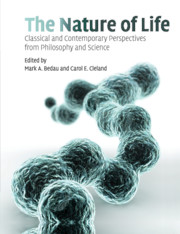Book contents
- Frontmatter
- Contents
- Preface
- Acknowledgments
- Sources
- About the authors
- Introduction
- SECTION I CLASSICAL DISCUSSIONS OF LIFE
- SECTION II THE ORIGIN AND EXTENT OF NATURAL LIFE
- SECTION III ARTIFICIAL LIFE AND SYNTHETIC BIOLOGY
- SECTION IV DEFINING AND EXPLAINING LIFE
- 23 Definitions of life
- 24 The seven pillars of life
- 25 A universal definition of life: autonomy and open-ended evolution
- 26 Does ‘life’ have a definition?
- 27 Sentient symphony
- 28 What is life?
- 29 Universal Darwinism
- 30 What is life? Was Schrödinger right?
- 31 Four puzzles about life
- Supplementary bibliography on life
- Index
- References
31 - Four puzzles about life
Published online by Cambridge University Press: 10 November 2010
- Frontmatter
- Contents
- Preface
- Acknowledgments
- Sources
- About the authors
- Introduction
- SECTION I CLASSICAL DISCUSSIONS OF LIFE
- SECTION II THE ORIGIN AND EXTENT OF NATURAL LIFE
- SECTION III ARTIFICIAL LIFE AND SYNTHETIC BIOLOGY
- SECTION IV DEFINING AND EXPLAINING LIFE
- 23 Definitions of life
- 24 The seven pillars of life
- 25 A universal definition of life: autonomy and open-ended evolution
- 26 Does ‘life’ have a definition?
- 27 Sentient symphony
- 28 What is life?
- 29 Universal Darwinism
- 30 What is life? Was Schrödinger right?
- 31 Four puzzles about life
- Supplementary bibliography on life
- Index
- References
Summary
WHAT EXPLAINS THE PHENOMENA OF LIFE
Life seems to be one of the most basic kinds of actual natural phenomena. A bewildering variety of forms of life surrounds us, but we usually have no difficulty distinguishing the living from the nonliving. That flower, that mushroom, that worm, that bird are alive; that rock, that mountain, that river, that cloud are not. Just as any attempt to divide nature at its joints must account for mind and matter, so it must account for life.
Yet it is notoriously difficult to say what life is, exactly. Many have noted this (e.g., ref. 1); Farmer and Belin (ref. 2, p. 818) put the point this way:
There seems to be no single property that characterizes life. Any property that we assign to life is either too broad, so that it characterizes many nonliving systems as well, or too specific, so that we can find counter-examples that we intuitively feel to be alive, but that do not satisfy it.
The fact today is that we know of no set of individually necessary and jointly sufficient conditions for life.
Nevertheless, there is broad agreement that life forms share certain distinctive hallmarks. Various hallmarks are discussed in the literature, and Mayr's list is representative and influential:
All levels of living systems have an enormously complex and adaptive organization.
Living organisms are composed of a chemically unique set of macromolecules.
The important phenomena in living systems are predominantly qualitative, not quantitative.
All levels of living systems consist of highly variable groups of unique individuals.
[…]
- Type
- Chapter
- Information
- The Nature of LifeClassical and Contemporary Perspectives from Philosophy and Science, pp. 392 - 404Publisher: Cambridge University PressPrint publication year: 2010



